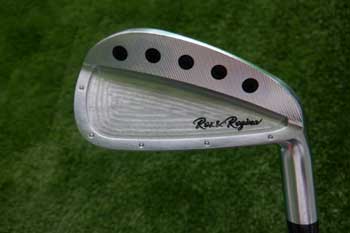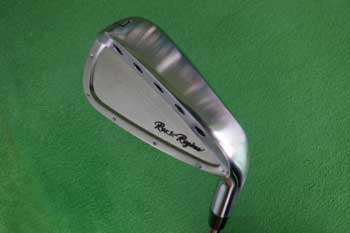Tested Review: Japanese golfclubs EPON AF-506 Irons – High Launch, Long Distance, Supreme Forgiveness

I recently had the chance to test out this impressive **golf club**.
The **test club** was the EPON AF-506 Iron, 7-iron.

It was shafted with the N.S.PRO MODUS3 TOUR 120. The specs were: 31° loft, 36.75 inches in length, S flex, 114g shaft weight, D2.5 balance, 1.7 torque, mid-to-high kick point, and a total club weight of 429.5g.

This is one of the newest irons from EPON.
I tested the AF-306 recently, and the AF-506 is its sister model.
EPON is known for its clean, traditional irons, but they’ve also been producing models like this one, so I wasn’t surprised by its appearance.
Today, not only EPON but many other manufacturers are releasing similar styles.

The two weights on the back are a standout feature.
Just by looking at them, you can tell this is a “forgiving” or “automatic” style iron.
While the exact weight isn’t marked, these weights definitely feel impactful.
Being a pocket cavity design already implies a deep CG (center of gravity), and these added weights enhance that effect significantly.

It almost looks like armor — the design has a unique presence.
It’s not small at all. I’d call it semi-large in size.
Older pocket cavity irons often looked cheap and unattractive, but that’s not the case here.
The finish is high-end, and the club offers a strong sense of ownership pride.

This pocket cavity is impressively deep.
While shallow cavities are more common these days, deep cavities like this are still very popular.
Hollow-body irons are trending, but pocket cavities like this remain in high demand.
Despite the different looks, hollow-body and pocket cavity irons aim to achieve similar performance.
I’ve tested many of both types, and if I were to choose today, I’d lean toward pocket cavity irons.
While hollow irons are easier to clean — a factor I care about — I just can’t get used to their unique sound and feel at impact.
That said, not all hollow irons are bad — some are genuinely pleasant to hit.
Like anything, there’s a wide range within the category.

Let’s talk about distance — this iron absolutely impressed me with its raw power.
Distance-focused irons aren’t new to me, but I was still taken aback by how effortlessly it sent the ball flying past the 180-yard sign, even on mishits.
I deliberately tried to slice the ball, aiming for a cut shot, yet the ball barely veered right and still carried long. I intended to keep it under 150 yards, but it effortlessly went 30 yards beyond that — even on an off-center hit.
The only drawback was my inability to control the distance consistently due to my lack of skill — not the club’s fault.

The feel at impact was decent — soft, with good “ball contact” — though not in the gripping, grabbing way some players love.
Instead, it was light and a bit hollow, but not unpleasant. I’ve felt this type of feedback before — some golfers may actually prefer it for its crisp simplicity.

The launch is phenomenal. Despite its strong loft, the ball soared impressively high — high enough to touch the net above.
It’s what I’d call “expressionless flight”: the ball just lifts and goes. Not the kind of spinny, high-launch from a normal loft, but rather a clean strike with serious carry.
That’s the hallmark of a low and deep center of gravity — a flight built into the head design itself.

Stability is where this club really shines.
It’s incredibly forgiving — even with off-center hits or glancing blows, the head doesn’t twist. The ball stays on line.
The clean look at address no doubt helps with alignment, and the club seems to “auto-correct” your path — putting you on the target line with ease.
The only thing left to master is gauging distance.

Workability isn’t its strong point.
I tried to bend the ball both ways, but it just wouldn’t shape. Even when I deliberately struck toward the toe, the ball came out nearly straight — maybe a soft fade at most.
That said, this behavior isn’t due to a flaw in my swing — I tested a muscle-back iron afterward and was able to shape shots easily. It’s just how the AF-506 is designed.
It’s meant for stability, not artistry. In a way, this club’s insensitivity is its biggest strength — it forgives and delivers consistent, automatic performance.

From the very first shot, I felt the club almost takes over — delivering a consistently strong and straight flight.
Some might feel frustrated by the lack of shot shaping, but that’s actually this iron’s greatest strength.

It’s the kind of club where you line up your shot, trust your aim, and just let the club do its job — and it will.
Even under pressure, that level of ease is a major asset.

The ball flight and trajectory feel “automated” — each shot travels the same dependable path.
It’s like a baseball pitcher who doesn’t rely on trick pitches but dominates with sheer power — a fastball you just can’t hit even if you know it’s coming.

High launch doesn’t mean weak — these are solid, powerful shots with a “heavy ball” feel.
Mastering the distance is key. I’m not used to such long-hitting irons, but if you are — or can adapt — this will be a strong partner on the course.
Direction and height are consistent, but I’d like to see how well it stops on real greens given its strong loft and limited spin.

This iron excels in “ease of launch,” “distance,” and “stability,” without the quirks or difficulty of older GI irons.
It’s easy to set up and visualize your shot, which adds to its consistent accuracy.
Even on narrow fairways or long par 5s, this iron can deliver.

While I still prefer more “manual” irons, if I ever feel the need to switch to something more forgiving, this would be my first choice.
It’s high-tech, but not “too high-tech” — balanced and reliable.
It’ll suit not only mid-to-low handicappers, but also newer golfers thanks to its wide performance envelope.
It’s a truly “level-free” iron — skill level doesn’t matter.
If there’s a drawback, it’s perhaps that it hits too far for players who prefer precision over distance. But that’s a rare concern these days.
Bottom line? Even beginners deserve the right to play EPON.
Final Ratings
Setup Ease: ★★★★☆
Feel: ★★★☆☆
Launch: ★★★★★
Forgiveness: ★★★★★
Distance: ★★★★☆
Workability: ★★☆☆☆
(★ = 0–20 pts | ★★ = 21–40 | ★★★ = 41–60 | ★★★★ = 61–90 | ★★★★★ = 91–100)
More EPON Reviews
All Iron Reviews
Official EPON Golf Online Store









